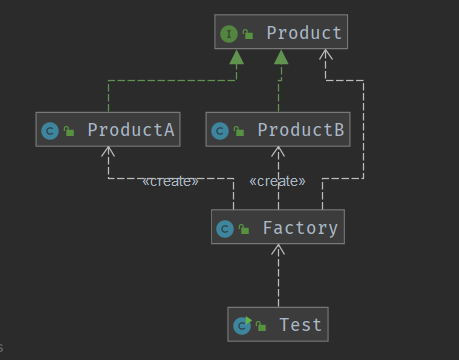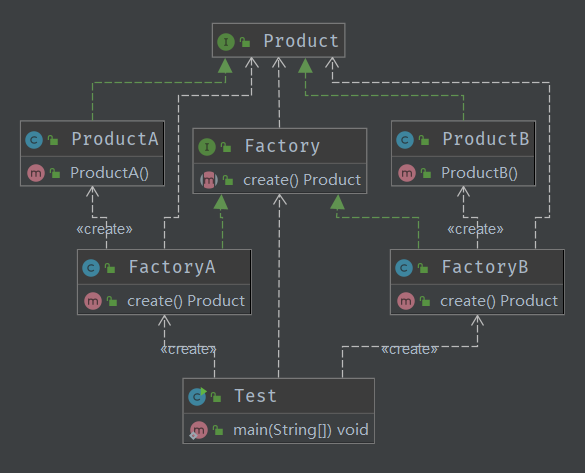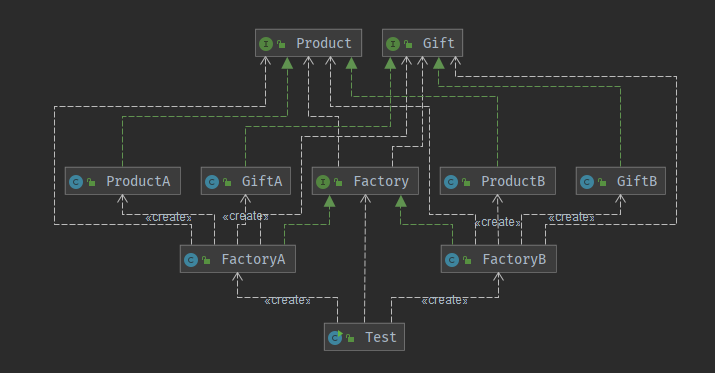设计模式-工厂模式
简单工厂模式
简单工厂模式是属于创建型模式,是工厂模式的一种。简单工厂模式是由一个工厂对象决定创建出哪一种产品类的实例。简单工厂模式是工厂模式家族中最简单实用的模式
简单工厂模式:定义了一个创建对象的类,由这个类来封装实例化对象的行为(代码)
在软件开发中,当我们会用到大量的创建某种、某类或者某批对象时,就会使用到工厂模式.
1.创建产品接口和对象
1
2
3
4
5
6
7
8
9
10
11
12
13public interface Product {
//共同的方法
}
public class ProductA implements Product {
public ProductA(){
System.out.println("ProductA");
}
}
public class ProductB implements Product {
public ProductB(){
System.out.println("ProductB");
}
}2.创建简单工厂
1
2
3
4
5
6
7
8
9
10
11
12public class Factory {
public static Product create(String str){
if (str.equals("ProductA")){
return new ProductA();
}else if (str.equals("ProductB")){
return new ProductB();
}
return null;
}
}3.调用
1
2
3
4
5
6
7
8
9
10public class Test {
public static void main(String[] args) {
Factory.create("ProductA");
Factory.create("ProductB");
}
}
/*
ProductA
ProductB
*/

应用实例:
1、您需要一辆汽车,可以直接从工厂里面提货,而不用去管这辆汽车是怎么做出来的,以及这个汽车里面的具体实现
2、Hibernate 换数据库只需换方言和驱动就可以
优点:
1、一个调用者想创建一个对象,只要知道其名称就可以了
2、扩展性高,如果想增加一个产品,只要扩展一个工厂类就可以
3、屏蔽产品的具体实现,调用者只关心产品的接口
缺点:
每次增加一个产品时,都需要增加一个具体类和对象实现工厂,使得系统中类的个数成倍增加,在一定程度上增加了系统的复杂度,同时也增加了系统具体类的依赖
这并不是什么好事
使用场景:
1、日志记录器:记录可能记录到本地硬盘、系统事件、远程服务器等,用户可以选择记录日志到什么地方
2、数据库访问,当用户不知道最后系统采用哪一类数据库,以及数据库可能有变化时
3、设计一个连接服务器的框架,需要三个协议,”POP3″、”IMAP”、”HTTP”,可以把这三个作为产品类,共同实现一个接口
工厂方法模式
所有工厂模式都用来封装对象创建,工厂方法模式通过让子类决定该创建的对象是什么,来达到将对象创建的过程封装的目的。
工厂方法模式定义了一个创建对象的接口,但由子类决定要实例化的类是哪一个,工厂方法让类把实例化推迟到子类
创建产品接口和产品
1
2
3
4
5
6
7
8
9
10
11
12
13public interface Product {
//共同的方法
}
public class ProductA implements Product {
public ProductA(){
System.out.println("ProductA");
}
}
public class ProductB implements Product {
public ProductB(){
System.out.println("ProductB");
}
}创建工厂接口,具体产品的工厂类
1
2
3
4
5
6
7
8
9
10
11
12
13
14
15
16
17
18public interface Factory {
public Product create();
}
public class FactoryA implements Factory{
public Product create() {
return new ProductA();
}
}
public class FactoryB implements Factory {
public Product create() {
return new ProductB();
}
}测试
1
2
3
4
5
6
7
8
9
10
11public class Test {
public static void main(String[] args) {
Factory factory;
factory = new FactoryA();
factory.create();
factory = new FactoryB();
factory.create();
}
}
/*ProductA
ProductB*/

简单工厂和工厂方法之间的差异?
简单工厂是在一个地方把所有的事都处理完了,然而工厂方法却是创建一个框架,让子类决定要如何实现。简单工厂的做法,可以将对象的创建封装起来,但是简单工厂不具备工厂方法的弹性,因为简单工厂不能变更正在创建的产品。
抽象工厂模式
抽象工厂模式:定义了一个interface用于创建相关或有依赖关系的对象簇,而无需指明具体的类
- 抽象工厂模式可以将简单工厂模式和工厂方法模式进行整合。
- 从设计层面看,抽象工厂模式就是对简单工厂模式的改进(或者称为进一步的抽象)。 将工厂抽象成两层,AbsFactory(抽象工厂) 和 具体实现的工厂子类。程序员可以
- 根据创建对象类型使用对应的工厂子类。这样将单个的简单工厂类变成了工厂簇,更利于代码的维护和扩展。
案例
创建Product产品类
1
2
3
4
5
6
7
8
9
10
11
12
13public interface Product {
//共同的方法
}
public class ProductA implements Product {
public ProductA(){
System.out.println("ProductA");
}
}
public class ProductB implements Product {
public ProductB(){
System.out.println("ProductB");
}
}创建Gift产品类
1
2
3
4
5
6
7
8
9
10
11
12
13public interface Gift {
}
public class GiftA implements Gift {
public GiftA() {
System.out.println("GiftA");
}
}
public class GiftB implements Gift {
public GiftB() {
System.out.println("GiftB");
}
}创建抽象工厂
1
2
3
4
5public interface Factory {
public Product createProduct();
public Gift createGift();
}创建A,B两个工厂实现类
1
2
3
4
5
6
7
8
9
10
11
12
13
14
15
16
17
18
19
20
21
22
23
24
25public class FactoryA implements Factory {
public Product createProduct() {
return new ProductA();
}
public Gift createGift() {
return new GiftA();
}
}
public class FactoryB implements Factory {
public Product createProduct() {
return new ProductA();
}
public Gift createGift() {
return new GiftA();
}
}测试
1
2
3
4
5
6
7
8
9
10
11
12
13
14
15public class Test {
public static void main(String[] args) {
Factory factory;
factory = new FactoryA();
factory.createProduct();
factory.createGift();
factory = new FactoryB();
factory.createProduct();
factory.createGift();
}
}
/*ProductA
GiftA
ProductB
GiftA*/
缺点:
产品族扩展非常困难,要增加一个系列的某一产品,既要在抽象的 Creator 里加代码,又要在具体的里面加代码
使用场景:
1、QQ 换皮肤,一整套一起换
2、生成不同操作系统的程序
注意事项:
产品族难扩展,产品等级易扩展
区别:
工厂方法模式: 一个抽象产品类,可以派生出多个具体产品类。 一个抽象工厂类,可以派生出多个具体工厂类。 每个具体工厂类只能创建一个具体产品类的实例。
抽象工厂模式: 多个抽象产品类,每个抽象产品类可以派生出多个具体产品类。 一个抽象工厂类,可以派生出多个具体工厂类。 每个具体工厂类可以创建多个具体产品类的实例。
区别: 工厂方法模式只有一个抽象产品类,而抽象工厂模式有多个。 工厂方法模式的具体工厂类只能创建一个具体产品类的实例,而抽象工厂模式可以创建多个
在service层中
1 | Dao userDao = new UserDao |
这个代码导致了Service层和Dao层紧密结合
如何选择
- 从设计原则来说,简单工厂模式不符合开闭原则。但是很神奇,在实际场景中,简单工厂模式确实用的最多的。个人觉得有以下这些原因
- 相对实现方式比较简单,维护起来也不困难。
- 实际场景中需要工厂模式创建的对象数量一般也不会特别多。
- 可以通过反射+外部配置文件的手段解决开闭原则的问题。
- 工厂方法模式是专门用于解决单个对象创建工作,本身模式没问题,也符合开闭原则。但是存在工厂类数量膨胀的问题。如果需要创建的工厂类不是很多,是一种不错的选择。
- 抽象工厂模式天生就是为生产产品族而生的。所以如果你需要创建的对象非常之多,但是对象之间存在明显产品族特征,那么这个时候用抽象工厂模式非常合适。
JDK中的工厂模式
JDK-Calendar
1 | private static Calendar createCalendar(TimeZone zone, |
除了日历类还有JDBC,当我们需要MySQL数据库的驱动时,我们就传MySQL的参数,用Oracle的就传相应的参数




